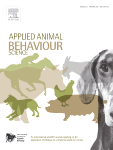Document type : Scientific article published in PLOS ONE
Authors: Francesca Marcato, Henry van den Brand , Christine A. Jansen, Victor P. M. G. Rutten, Bas Kemp, Bas Engel, Maaike Wolthuis-Fillerup, Kees van Reenen
Preview: The aim of this study was to investigate effects of pre-transport diets, transport durations and transport conditions on immune cell subsets, haptoglobin, cortisol and bilirubin of young calves upon arrival at the veal farm. An experiment was conducted with a 2 × 2 × 2 factorial arrangement with 3 factors: 1) provision of rearing milk or electrolytes at the collection center (CC); 2) transport duration (6 or 18 hours) and 3) transport condition (open truck or conditioned truck). Holstein-Friesian and cross-bred calves were used (N = 368; 18 ± 4 days; 45.3 ± 3.3 kg). Blood samples were collected from calves (N = 128) at the collection center, immediately post-transport (T0) and 4, 24, 48 hours, week 1, 3 and 5 post-transport. Blood was analyzed for cortisol, bilirubin, haptoglobin, IgG and IgM. Moreover, cell counts of neutrophils, lymphocytes, monocytes, basophils and eosinophils were measured in blood samples taken at the collection center and T0. In these same blood samples, different lymphocyte populations were characterized by flow cytometry, including CD14+ cells, NK cells, δγ+ T cells, CD8+ cells, CD4+ cells and CD21+ cells. Calves transported in the conditioned truck had higher amounts of white blood cell count (WBC) (Δ = 1.39 × 109/l; P = 0.01), monocytes (Δ = 0.21 × 109/l; P = 0.04), neutrophils (Δ = 0.93 × 109/l; P = 0.003), than calves transported in the open truck regardless, of pre-transport diet or transport duration. The study showed that transport condition and duration influenced parts of the innate immune system of young calves. Cortisol, bilirubin and WBC seemed to be connected by similar underlying mechanisms in relation to transport conditions. However, it is unclear which specific pathways in the immune system of young calves are affected by different transport conditions (e.g. temperature, humidity, draught).






